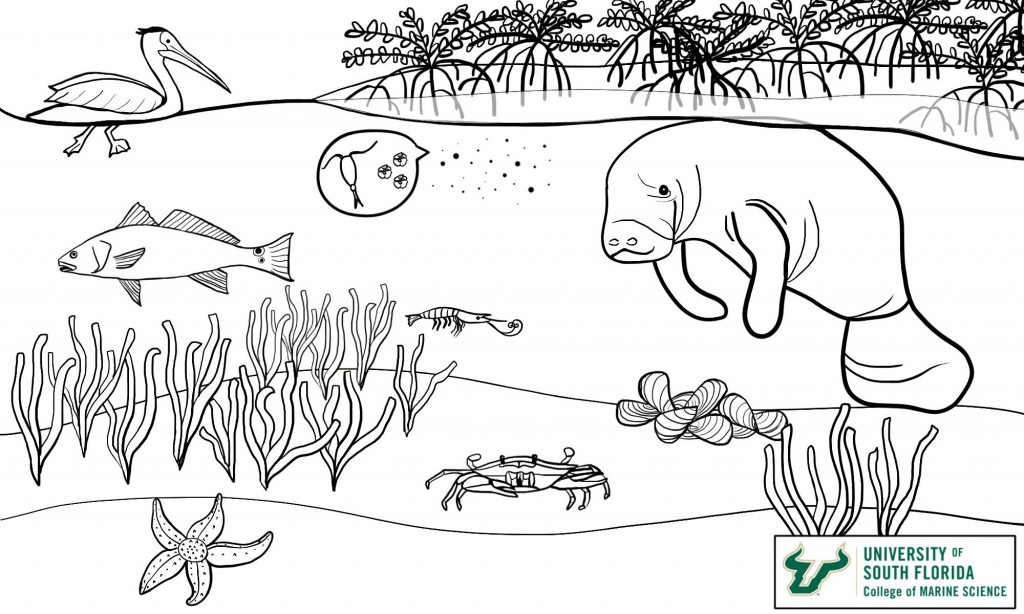Virus Hunters
2021 St. Petersburg Science Festival Activity
Activity Description:
Join us to explore the world of viruses! All living things can become infected with viruses, including humans, animals, plants, and even bacteria. We are sure you have heard of the coronavirus that causes COVID-19, but did you know that our oceans are full of viruses? Not all viruses cause disease, and some can even help people! Become a virus hunter and discover viruses that infect organisms in coastal environments using an interactive website and worksheet.
Presented by: The University of South Florida College of Marine Science – Breitbart Lab

Watch the 2021 recorded St. Petersburg Science Festival video here:
Find My Host Activity:
All living things can be infected by viruses. Use this worksheet to find the host organism that best matches the description. Using the interactive website, click the star to reveal a virus that infects each host.
Easy Version:
- This plant lives on the seafloor in shallow waters, where its long leaves help small sea critters hide from hungry predators.
- This critter normally has 5 arms, which help it walk on the ocean floor. It can regrow arms that are cut off.
- This small animal drifts with the currents, eating tiny single-celled plants.
- This animal has fins that help it swim. It uses gills to breathe underwater.
- This creature has two shells that help protect its very soft body. It filters food out of the water.
- This creature mostly lives on the bottom and uses two claws to collect food and protect itself.
- This long bodied, small creature swims quickly by bending in half and flicking its body. It has two pairs of long antennae at the top of its head and many little legs.
- This large creature is known for being very friendly and slow moving. It has a large, flat, rounded tail and a pig-like snout.
- This creature can fly high in the sky with its big wings. It eats fish by scooping them out of the water with its large beak.
- This tree has large roots that provide homes for many creatures. Many of these trees can grow together to form islands.
- This tiny plant-like creature lives at the surface of the water. When there are lots of this creature in the water, they form a red tide that is dangerous to plants and animals.
- Where do all these creatures live??
Hard Version:
- This bivalve builds reefs that help protect our coastlines. It filter feeds all day long, eating algae and other plankton from the water.
- This microscopic zooplankton is the most abundant animal in the ocean.
- This organism migrates through the United States annually. It uses its large beak to scoop fish out of the water.
- This microscopic dinoflagellate is the organism that causes red tide. It releases neurotoxins called brevetoxins that harm marine life.
- This organism has large, strong roots that hold sediment in place, protecting our coastlines. It excludes salt from its roots, allowing it to live in or near salt water, unlike most plants.
- This small organism has a long body with many appendages that help it swim and walk. It is an omnivore that scavenges food from the water column and sea floor.
- This organism is an echinoderm, meaning it has “spiny skin.” Using hundreds of tube feet on its arms, it crawls along the seafloor searching for food.
- This mammal can be found eating seagrass in shallow waters. There are many no wake zones in Florida for these gentle giants.
- This organism provides habitat for small invertebrates and fishes on the seafloor in shallow environments. It is eaten by manatees, turtles, and many other marine creatures.
- This organism has a hard exoskeleton and 4 pairs of walking legs that help it walk on the seafloor. It also has 2 claws that help protect it from predators and collect food.
- This organism is cold-blooded and has gills, a swim bladder, and fins.
- Where do all of these organisms live??
Virus Hunters Coloring Page
Download the image below by right clicking and selecting Save image as…

Illustrations by: Makenzie Kerr
Additional Resources:
Ameoba Sisters Video – Viruses: https://www.youtube.com/watch?v=8FqlTslU22s&vl=en&ab_channel=AmoebaSisters
Virus Snowflakes Activity – Cut out your own virus shaped snowflake: https://www.gla.ac.uk/media/Media_765622_smxx.pdf
Phage Heroes Activity – Learn about superhero viruses that infect bad bacteria: https://www.ncbi.nlm.nih.gov/pmc/articles/PMC5969416/